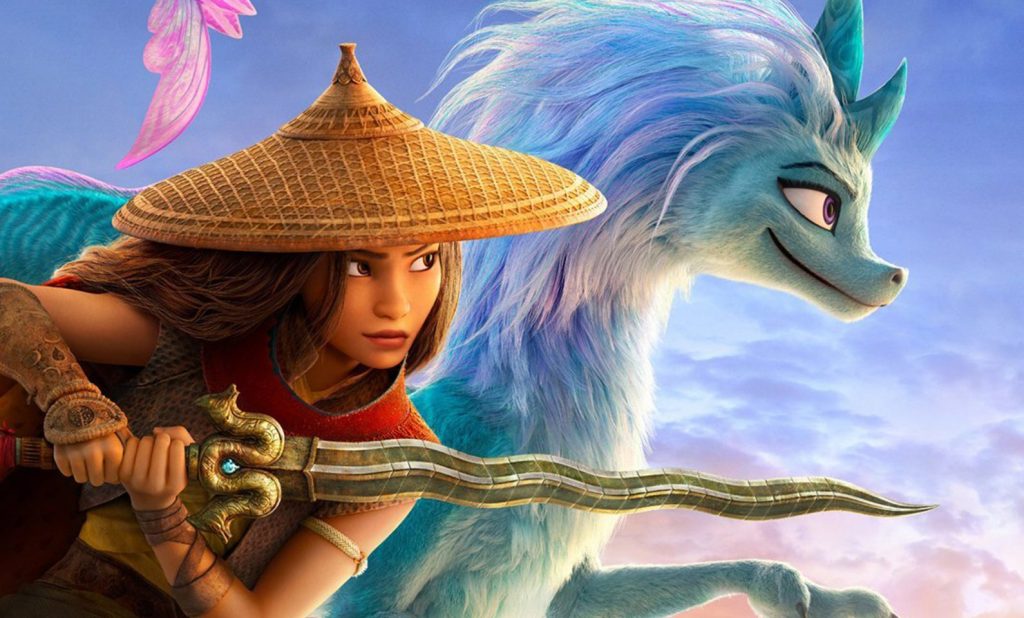Truly transportive movies feel like a precious commodity currently. So many studio films are related to existing properties that the worlds they give us feel mundane by now, and a lot of these fictional locales are gritty reimaginings of already familiar settings, so the escapes we do get aren’t pleasant ones. During a period where we’re still stuck in our houses with a limited travel radius, movies featuring beautiful, detailed, diverse fantasy worlds feel like an infusion of sunlight and hope. When one of these movies features timely messages about trust and community, it becomes a power punch that can’t be denied.
Disney’s Raya and the Last Dragon fires on all cylinders, and would likely play well even if it were released during non-pandemic times. However, it gets extra mileage out of being a wildly fun, great-looking and touching family movie at a moment when all of those things are in short supply. Raya features a gorgeous, immersive fantasy world with southeast Asian influences, complex female characters who hold their own, and a moving message about mending cultural divisions and rebuilding trust.
Raya (Kelly Marie Tran) lives in a land called Kumandra, which 500 years ago was saved from a shadowy plague called the druun by a dragon named Sisu. Sisu gave up her magic to create the dragon stone, a gem that keeps the druun at bay. Since Sisu’s self-sacrifice, Kumandra has fought over ownership of the dragon stone, splitting into five warring nation-states. Raya’s home is the location of the dragon stone, and as heir to the throne, she’s being trained to guard it by her father, Chief Benja (Daniel Dae Kim).
Benja tries to establish unity at a meeting of the five states. When Raya mistakenly trusts her new friend Namaari (Gemma Chan) by showing her the dragon stone, a fight ensues that splits the stone in pieces and brings back the druun. Six years later, Raya rides her plucky animal sidekick Tuk-Tuk (a giant fuzzy chipmunk pillbug) around Kumandra trying to locate Sisu’s fabled resting place to bring back the dragon and fix her damaged world. Raya finds Sisu, but the goofy, insecure dragon (Awkwafina) isn’t the leader she’s expecting.
With apologies to Pixar, Raya and the Last Dragon is one of the prettiest pieces of animation to come out of Disney in years. The landscapes are grand and breathtaking. The textures of clothes, hair and surfaces are so carefully rendered you can almost feel them. Don Hall and Carlos López Estrada’s direction is anchored by a sense of place that’s distinct to each of the separate states of Kumandra: dusty deserts, lantern-lit canals, lush forests, and frozen tundra.
Qui Nguyen and Adele Lim’s screenplay contains sincere drama and relatable parallels about societal division and working to re-establish community even when it seems impossible. The druun may be a supernatural force, but it’s suggested that it’s one born of human darkness and conflict. The only way to fight it is together. As Raya and Sisu gain allies in their quest, the bonds they form with unlikely friends (including an infant pickpocket, an axe-wielding warrior and a pint-sized shrimp boat captain) make them stronger, happier and more capable.
Raya and the Last Dragon is full of fun action, humor, and creativity that’s unlike anything Disney has produced up until now. It’s made in the tradition of the best genre storytelling, creating a fully-realized world where none of the elements seem generic. It’s bolstered by a message of healing and emotional vulnerability that feels particularly important right now. Raya provides a worthy message for kids and adult viewers, in the vehicle of an outstanding fantasy adventure.
A
“Raya and the Last Dragon” is out Friday in theaters, and will be available for premium viewing on Disney+.

